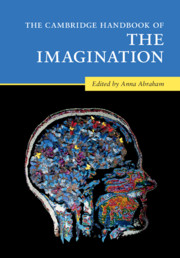Book contents
- The Cambridge Handbook of the Imagination
- The Cambridge Handbook of the Imagination
- Copyright page
- Dedication
- Contents
- Figures
- Contributors
- Acknowledgments
- 1 Surveying the Imagination Landscape
- Part I Theoretical Perspectives on the Imagination
- Part II Imagery-Based Forms of the Imagination
- Part III Intentionality-Based Forms of the Imagination
- Part IV Novel Combinatorial Forms of the Imagination
- 27 On the Interaction Between Episodic and Semantic Representations – Constructing a Unified Account of Imagination
- 28 How Imagination Supports Narrative Experiences for Textual, Audiovisual, and Interactive Narratives
- 29 Development of the Fantasy-Reality Distinction
- 30 Imagining the Real: Buddhist Paths to Wholeness in Tibet
- 31 Hypothetical Thinking
- 32 The Counterfactual Imagination: The Impact of Alternatives to Reality on Morality
- 33 A Look Back at Pioneering Theories of the Creative Brain
- Part V Phenomenology-Based Forms of the Imagination
- Part VI Altered States of the Imagination
- Name Index
- Subject Index
- References
30 - Imagining the Real: Buddhist Paths to Wholeness in Tibet
from Part IV - Novel Combinatorial Forms of the Imagination
Published online by Cambridge University Press: 26 May 2020
- The Cambridge Handbook of the Imagination
- The Cambridge Handbook of the Imagination
- Copyright page
- Dedication
- Contents
- Figures
- Contributors
- Acknowledgments
- 1 Surveying the Imagination Landscape
- Part I Theoretical Perspectives on the Imagination
- Part II Imagery-Based Forms of the Imagination
- Part III Intentionality-Based Forms of the Imagination
- Part IV Novel Combinatorial Forms of the Imagination
- 27 On the Interaction Between Episodic and Semantic Representations – Constructing a Unified Account of Imagination
- 28 How Imagination Supports Narrative Experiences for Textual, Audiovisual, and Interactive Narratives
- 29 Development of the Fantasy-Reality Distinction
- 30 Imagining the Real: Buddhist Paths to Wholeness in Tibet
- 31 Hypothetical Thinking
- 32 The Counterfactual Imagination: The Impact of Alternatives to Reality on Morality
- 33 A Look Back at Pioneering Theories of the Creative Brain
- Part V Phenomenology-Based Forms of the Imagination
- Part VI Altered States of the Imagination
- Name Index
- Subject Index
- References
Summary
Imagination is crucial in the Buddhist contemplative practices of Tibet. And yet the path to freedom in which they participate requires release from all imagining. This conundrum leads us to examine a sequence of practices from two of Tibet’s greatest poet-philosopher–practitioners, Longchen Rabjampa and Jigme Lingpa. In our reading, their instructions identify somatic, cognitive, creative, intentional, distracted, confused, or corrective states of imagination. Intentional imagining is an intentional method for resolving confused or distracted imagining. In detailing this we ask also how imagination differs from or overlaps with thought. We find that training in the intentional can elicit transmodal perception of reminiscence of what we knew as infants, suggesting that the imagination helps take us deep into body-mind memory. Finally, and especially significant for insights into the deep structure of perception, we note Dzogchen’s appreciation of the imagination’s capacity for dissolving itself, into a particularly expansive dimension of human experience.
Keywords
- Type
- Chapter
- Information
- The Cambridge Handbook of the Imagination , pp. 500 - 513Publisher: Cambridge University PressPrint publication year: 2020



